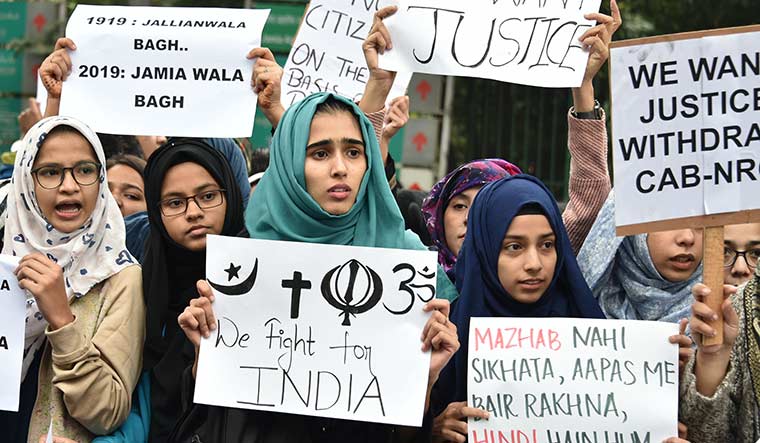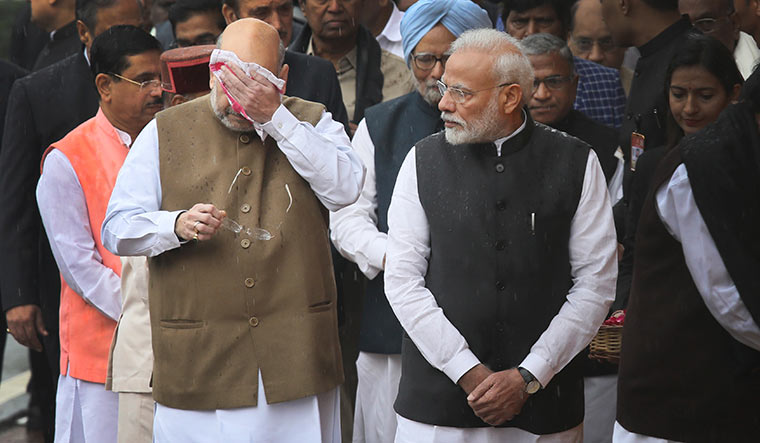Mohammad Mustafa was clear about his goal. Clearing the UPSC exam. After completing his MBA, he joined for another master’s degree programme at Jamia Millia Islamia to have access to the library. He saw political protests as a distraction. That is, till December 15. As he sat in a corner of the library immersed in his books, he suddenly saw policemen storming the room.
“They just started hitting,” he said. “The policemen refused to listen when I told them that I did not participate in protests. They broke my laptop. I begged them not to hit me on my head; I received lathi blows on my hands. I was taken to the police station and made to sit on the cold floor. My hand is fractured.”
The government should win hearts through [campaigns like] Swachh Bharat and not divide people on religious lines. For the first time, I experienced that people who do not participate in protests can also be victims. I realised no one is safe. We have seen that order based on religion is not successful, as is the case in Pakistan.”
Mustafa was among several students who were injured in police action after violence broke out during protests against the new Citizenship Amendment Act in Delhi. With similar scenes playing out at Aligarh Muslim University and a few others, protests broke out on campuses across India. The vocal participation of the female students of Jamia, especially, became a cause célèbre even for the apolitical.
The CAA would grant Indian citizenship to Hindus, Sikhs, Buddhists, Jains, Parsis and Christians who have migrated to India after facing religious persecution in Pakistan, Afghanistan or Bangladesh. The anti-CAA protests were initially confined to the northeast, but soon spread elsewhere, and especially among Muslims. The community feels that they would have to prove their origins if the National Register of Citizens is implemented, and that the subsequent religious omission under the CAA would uproot them. The BJP’s promise to implement the NRC nationwide has added to this feeling of insecurity.
The government, apparently, had not anticipated such a response. In its earlier ideological initiatives, including removal of Article 370, implementation of the NRC in Assam, banning triple talaq, and batting for the Ram temple in Ayodhya, the Centre had found support, or at least silent acquiescence, from the vast majority. But the passing of CAB was the first time religion was made central to a legislation, and this has led to extensive polarisation in the country.
What made these protests different was the lack of visible leadership guiding the students. The outpouring of support was reminiscent of similar protests during the anti-corruption movement and the anti-rape protests following the 2012 gang-rape in Delhi. And this has vexed the Union government, which has found that it is easier to take control of the narrative when political parties are involved.
In recent elections rallies in Jharkhand, Prime Minister Narendra Modi and Home Minister Amit Shah have pinned the blame on the Congress and other parties for spreading misinformation about the new law. They made attempts to assure Indian Muslims that the legislation would in no way impact them.
If it was the BJP that took the Centre’s message to the grassroots earlier, now the government itself has decided to educate people about the law. Following some intelligence reports, the government is also keeping a tab on social media posts to curb rumours and misinformation.
Passing of the bill has also brought opposition parties together. The states of Punjab, Chhattisgarh, Madhya Pradesh, Kerala and West Bengal have said they would not implement CAA; but as it is a Central law, they would have to do so. In fact, Shah has already told these states they have no choice in the matter and that the Centre would not rethink the law.
“We are going to people with facts and figures, but these opposition parties are trying to instigate the people,” said BJP spokesperson Sambit Patra. “They want to polarise the country along religious lines, be it on the citizenship law or Article 370. The Congress is frustrated. The new law does not take away anyone’s citizenship, but only grants it to persecuted minorities of Pakistan, Bangladesh and Afghanistan.”
According to official data, in the past six years, 2,830 Pakistanis, 912 Afghanis and 172 Bangladeshis have been given Indian citizenship. Of these, 566 were Muslims from Pakistan. India also gave citizenship to 14,864 Bangladeshis after incorporating more than 50 Bangladesh enclaves into Indian territory post a boundary agreement between the two countries in 2014.
The Union government has said that CAA does not stop any foreigner from applying for Indian citizenship. The Baloch, Ahmadiyas and Rohingyas can apply for Indian citizenship if they fulfil the requirements of The Citizenship Act, 1955. Moreover, the Centre has said that CAA does not cover deportation, which is under The Foreigners Act and The Passports Act.
As for the opposition parties, they have been careful not to be branded as fighting for a ‘Muslim cause’, as they feel any religious polarisation would ultimately benefit the BJP.
“It is wrong to say that the Congress is behind the agitation,” said Congress leader Ghulam Nabi Azad. “Had we been so strong, the BJP would not have been in power. The government is responsible for this. They brought this divisive legislation.”
In the coming days, the opposition parties would focus on the threat they feel the law poses to the Constitution. There are already five dozen petitions before the Supreme Court, which will decide if the law violates the fundamental articles in the Constitution, and if the law changes the basic structure of the Constitution, which says there should be no discrimination based on religion.
But beyond the political battle, managing the widespread discontent could be a security nightmare for the Union government. For Assam, the NRC was an emotive issue as the indigenous people viewed the Bengali-speaking outsiders—Hindus and Muslims—with suspicion. But this feeling was not new and the home ministry was confident of tackling any law and order issues. The citizenship amendment law, however, brought the protests from the Brahmaputra and Barak valleys to the fertile Ganga plains.
After the bill was passed, some officials in the foreigners division of the home ministry, who had earlier handled citizenship cases, were called from their offices in Major Dhyan Chand Stadium in Delhi to North Block to discuss the contours of CAA with Union Home Secretary A.K. Bhalla. But, soon, the ministry realised that it was more than a perception battle. The matter passed from the foreigners division to the internal security division under Shah. While law and order is a state subject, the internal security division is responsible for liaising with states on national security concerns. There were also debates on whether the protests deserved to be labelled a national security concern.
Following the Delhi Police’s actions in Jamia, the home ministry issued an advisory to states and Union territories to take action against circulation of fake news and rumours on social media. Shah had realised that CAA had indeed transformed into a national security threat and that the Muslims could feel alienated. The NRC-CAA issue could even be similar to the Ram temple agitation in its heyday, where the country was divided on religious lines.
The challenge before the security establishment is manifold. For now, the home ministry is handling the protests as a law and order issue. In the coming days, it will quell the protests with an iron hand by booking offenders under stringent provisions and monitoring social media.
However, the single-biggest threat is the possibility of Muslims turning hostile. The community had, in the past six years, largely stayed silent despite many decisions impacting it. A senior intelligence official said that pan-Islamic beliefs have gained ground in recent years; the political ideology across the world has advocated the unity of Muslims, regardless of ethnicity. In such a situation, the perceived exclusion of the Muslims from CAA could trigger a larger sentiment, not just in India.
“Apart from law and order, the biggest concern is Islamic radicalisation,” said a senior intelligence officer. “India has 19 crore Muslims. Even if a fraction of them get inclined towards the hardcore ISIS ideology, which is aiming for a pan-Islamic sentiment to establish a caliphate, it will be a major concern. These disenchanted and radicalised Muslims can boost the banned organisation.”
For instance, the 2015 Rohingya crisis caused outrage in the Muslim world and in international fora. It also had its ripple effects in India, when the government refused to take in Rohingyas.
While intelligence reports said that several jihadi outfits, including Hafiz Saeed’s Jamaat-ud-Dawa, were trying to infiltrate the vulnerable Rohingyas, the displaced community was also finding support among most mainstream Muslim organisations. “The pan-Islamic sentiment could not be missed,” emphasised an intelligence official.



